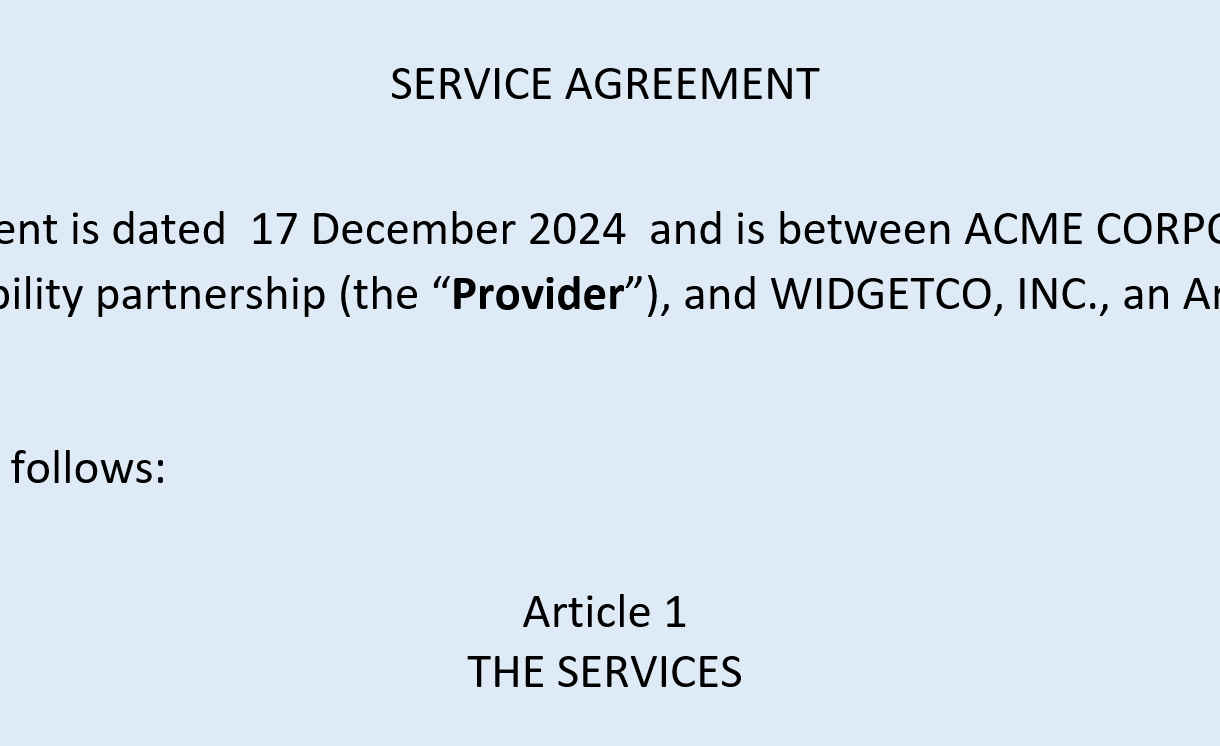
Last week, Kevin Miller, LegalSifter’s CEO, used Adams Contracts’ confidentiality agreement template. In the process, he suggested that I bold the title.
When Kevin shared his opinion, I realized I’ve never explained why I don’t bold the title, and no one had ever commented on that preference. So around 25 years into my grand adventure, allow me to articulate to myself, and share with you, for the first time why I don’t bold the title.
I think in terms of local conspicuousness and global conspicuousness. From the perspective of local conspicuousness, nothing is gained by bolding the title. It’s at the top of the contract, nothing impedes the reader from reading it, and it’s separated from the introductory clause that follows. Because bolding the title would be unnecessary, I’d find it intrusive.
But in terms of global conspicuousness, article headings are, like the title, in all caps, with no other emphasis. It follows that in my drafting, nothing suggests that the title takes primacy over article headings. But the title’s position and use of all caps are sufficient to signal the title’s primacy. No reader confusion is possible.
Furthermore, if a contract isn’t divided into articles, you’re not presented with the theoretical issue of the relationship of the title to article headings. It would be annoying to not bold the title for contracts without article headings but bold it for contracts with article headings. I’m comfortable with not bolding it in either case.
As you were!

Ken:
I’ve long disagreed with you on the use of all caps in titles of documents and articles. It’s kinda silly that the rest of the contract is in normal case or, at most, nit caps, but document and article headings are not. What’s wrong with just leaving it as ordinary test or not caps?
Chris
Hi Chris. Making some text conspicuous can serve a function. The only question is whether a given instance of conspicuousness, and the form of conspicuousness, in fact serves a function.
For example, I think using bold when you create a defined term serves a function.
Regarding contract titles, I’m OK with using all capitals. After all, it’s standard to emphasize titles. Could I have just used initial capitals? Sure, but titles often go beyond that. Given that there’s a constituency in favor of bold all capitals for titles, I’m taking a middle position. And I’m fine with it.
Ken,
I use your templates as the basis for all agreements I draft. And I’m certainly not looking to change your position on all-capitals text. I work for a public authority in Canada, so our documents are subject to accessible-content laws and standards. We avoid all-capitals typography because screen-reading and other assistive technology might try to treat words typed this way as an initialism or acronym and reading out each word letter by letter. This comes about in drafting because most people tend to type all-capitals text with Caps Lock on or by holding the Shift key (me included).
The more typography-oriented among us might wish to use word-processing styles where we’d like capital letters, having typed using the normal case and applying the style. Assistive technologies can then read these properly. But I recognize that this is a lot (too much, really) to ask when the goal is getting things done and when many have a hand in a draft. As you’ve observed, it’s not worth getting precious about transactional documents all out of proportion to what they’re for, so instead of arcane Microsoft Word tutorials, we default to normal case. In reviewing someone else’s draft, I tend to pick my battles and save my energy for blatant archaisms.
IN WITNESSETH WHEREOF I DO HEREBY WISH YOU WELL THIS THE SEASON OF HOLIDAYS and thank you for keeping up the good fight.